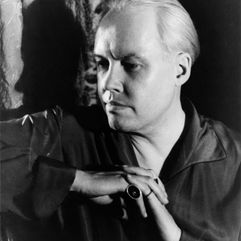

Carl Van Vechten
1880 - 1964
Born 1880 in Cedar Rapids, Iowa, Carl Van Vechten moved to New York City three years after earning his bachelor of philosophy degree in 1903 from the University of Chicago. As a novelist, photographer and patron of the arts, his contributions to the New York City cultural and social scene were significant.
Famously a socialite, Van Vechten regularly hosted receptions at his home during which intellectuals, theater stars, and literary figures interacted and formed interracial communities. Such a mélange of people often departed from socially accepted gatherings common in New York City during the early twentieth century. At a time when African Americans had great difficulty with purchasing opera tickets or getting service at downtown restaurants, Van Vechten created an alternative space in order to forward his artistic and professional aspirations while countering practices of racial segregation.
At the age of fifty, following the completion of his autographical novel, Sacred and Prophane Memories (1932), Van Vechten began photographing. He famously took portraits of a broad selection of noteworthy artists in the fields of music, literature, journalism and the visual and performing arts. Most of his portraits share a common aesthetic; the images, taken during private photography sittings in Van Vechten’s home, often include a backdrop of patterned or crinkled mylar material, with the half-length, animated subject taking up most of the shallow picture plane. Many of the portraits are rather playful, provocative, and often suggest performative elements.
Van Vechten took a particular interest in African American individuals and saw photography as a tool for advancing the acceptance and appreciation of black culture within American society. The African American portraits that comprise the ‘O. Write my Name’: American Portraits, Harlem Heroes reflect his commitment to portraiture as an art form with the capacity to change public opinion.
Van Vechten had grand aspiration for the project and he circulated and exhibited the portraits widely. He distributed postcards and 8 x 10 prints to friends and associates near and far. For those personally close to Van Vechten, it was not unusual for them to find a postcard with a brief note from the photographer in their mailboxes. He exhibited the portraits in unconventional spaces, including NYC’s Wadleigh High School, the windows of Roger Kent Stores, and Rockefeller Plaza. In 1941, a selection of prints were donated to Yale University as part of Van Vechten’s newly established James Weldon Johnson Memorial Collection of African American Arts and Letters.
‘O. Write my Name’ includes fifty of his portraits taken between 1930 and 1960 posthumously reproduced through a hand photogravure printing process on behalf of the Eakins Press Foundation in 1984. Richard Benson, who earned a MacArthur grant for his advancements in gravure printing techniques, printed for the series. Each print features a portrait inlayed above an accompanying text panel. The letter pressed text states the year of the photograph, the sitter’s name, a passage from an essay, interview or autobiography, and a few biographical sentences, which were all selected and arranged by the publisher to celebrate the photograph’s subject.
From literature, to dance, theater and photography, Carl Van Vechten saw the possibilities art provided as a tool for aesthetic exploration and social progress. He was the first American critic of modern dance for the New York Times and the author of numerous novels, including Peter Whiffle (1922), The Tattooed Countess (1924) and Spider Boy (1928). His most controversial novel, Nigger Heaven (1926) received sharp criticism for its offensive title and lowlife portrayal of African American characters. He died in New York City in 1964 at the age of eighty-four.
Text © Museum of Contemporary Photography, 2018











